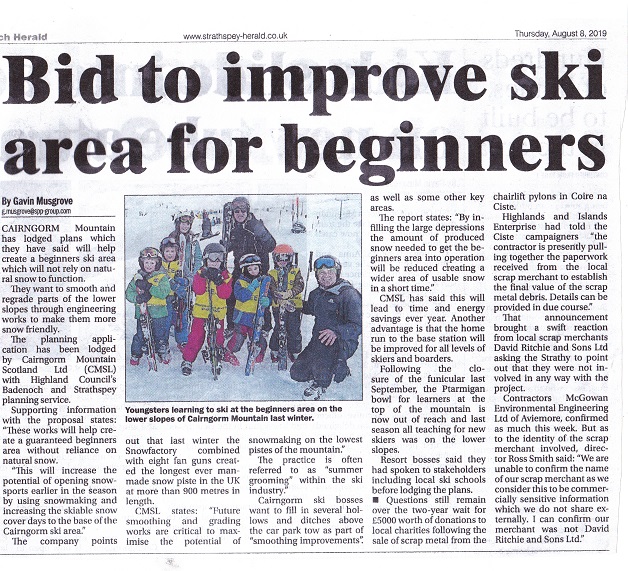 A couple of weeks ago Highlands and Islands Enterprise lodged yet another planning application for Cairn Gorm, this time for the creation of a beginners ski area above the day lodge (see here for planning documents). James Gibb from HIE made no mention of this at the meeting organised by the Aviemore and Community Trust where he claimed that HIE were committed to producing a masterplan at Cairn Gorm. There is no sight of that and meantime the individual planning applications keep rolling in (the Ptarmigan, the car park play tube and now this) while HIE has also advertised for a Project Manager to manage the repair of the funicular (see here) BEFORE they have indicated the likely cost of doing so. Thankfully the Cairngorms National Park Authority, whose Board in March asked HIE to produce a masterplan BEFORE they submitted any further planning applications, have decided to call-in the beginners ski area application. That means the CNPA Board will take the decision.
A couple of weeks ago Highlands and Islands Enterprise lodged yet another planning application for Cairn Gorm, this time for the creation of a beginners ski area above the day lodge (see here for planning documents). James Gibb from HIE made no mention of this at the meeting organised by the Aviemore and Community Trust where he claimed that HIE were committed to producing a masterplan at Cairn Gorm. There is no sight of that and meantime the individual planning applications keep rolling in (the Ptarmigan, the car park play tube and now this) while HIE has also advertised for a Project Manager to manage the repair of the funicular (see here) BEFORE they have indicated the likely cost of doing so. Thankfully the Cairngorms National Park Authority, whose Board in March asked HIE to produce a masterplan BEFORE they submitted any further planning applications, have decided to call-in the beginners ski area application. That means the CNPA Board will take the decision.
The idea behind the proposal is to better use of the snow created by the new snow making machines by flattening out the slopes. HIE’s argument is this will avoid “wasting” snow on filling in hollows.
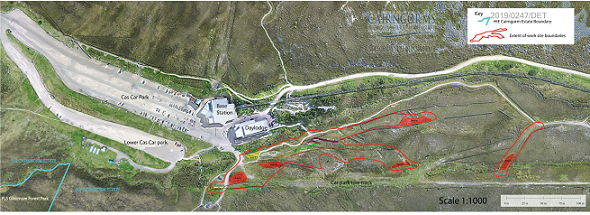
While ostensibly for the benefit of skiers and proposed in the SE Group report on the uplift infrastructure for skiing at Cairn Gorm, it makes little sense in terms of skiing:
- First, the area is too low down the mountain and Coire Cas is very exposed to the weather. HIE need to decide where the snow machines are most likely to make a difference BEFORE taking decisions about a beginners area.
- Second, one of the prime arguments for the funicular was to be able to ferry beginners up the mountain to the Ptarmigan bowl. If that is no longer suitable for beginners, HIE should say so but that removes one of the main arguments for repairing it!
- Third, two years ago HIE paid for the installation of the shieling rope arguing that a beginners areas was needed lower down the mountain. In the course of the construction, they allowed the whole area to be flattened. Why is another flattened ski area now required and wouldn’t it be better to move the snow making machines uphill so snow could be created where the lift is as Alan Brattey and others have argued?
- Fourth, locating the snow making machines by the car park has been beset with difficulties due to the high levels of grit in the water there. As this post will show, this appears partially a consequence of the creation of a new track by the Shieling Rope tow and is likely to become even worse if further engineering works to the ski slopes are allowed.
- Fifth, the SE group report which suggested a beginner’s area here included proposals for a magic carpet which would be installed once the area was flattened. Why is there no mention of this in the Planning Application?
All these issues are never going to be resolved so long as HIE continues punting individual planning applications at Cairn Gorm with no consideration of how these will all fit together. A masterplan for ALL ski infrastructure is desperately needed – the problem is HIE is not the organisation to do this, it has neither the knowledge, the skills or the vision necessary.
The likely environmental impacts of engineering a new beginners’ ski area

In my post on the damage down by the recent downpours in our National Parks (see here), I featured a couple of photos of erosion damage at the Shieling Track (included again below) BEFORE the recent downpours (and Aviemore has experienced some of the heaviest rain in Scotland). What’s happened at the Shieling should give the CNPA every reason it needs to demand HIE provide a full independent assessment of what impact the proposed development will have on water run-off and erosion.
Regular readers will recall how HIE failed to supervise Natural Retreats when installing the shieling rope tow and how far more extensive works were undertaken than were granted planning permission (see here). Having then failed to save sufficient vegetation to restore the slope they had scraped clean, Natural Retreats then applied for retrospective planning permission to create a new track running alongside the new piste (see here). Parkswatch and others, including the North East Mountain Trust, argued that the track was too steep and straight would as a consequence erode and that the ground should be fully restored. The CNPA rejected these concerns and granted planning permission on the basis that the track could be restored properly.
The latest photos from July 2019 show that the CNPA were wrong and the critics were right. The track is clearly eroding at a rapid rate and material is being washed down the mountain.
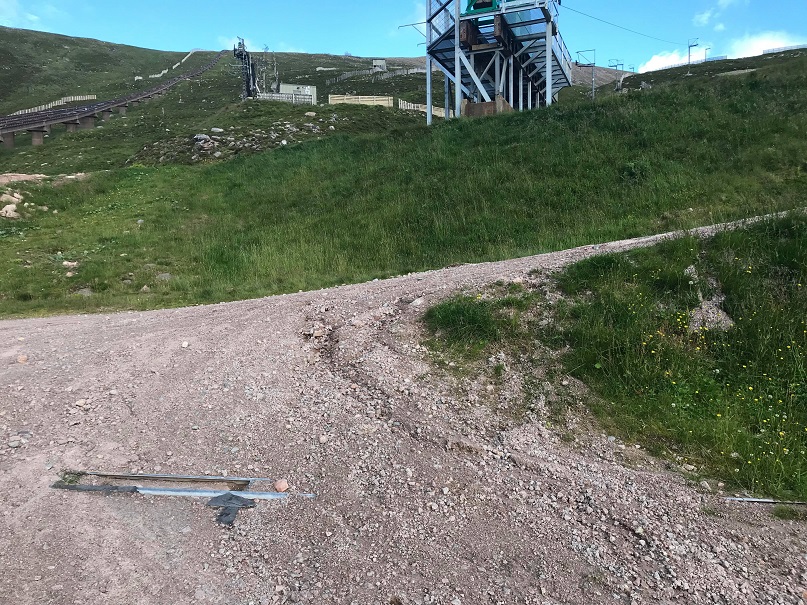
In the Committee Report to the Board about the Shieling track the following claim was made:
“Local Development Plan Policy 4: Natural Heritage seeks to ensure that new development does not adversely affect the quality of the environment or species. Policy 10: Resources seeks to ensure that new development avoids unacceptable detrimental impacts on the water environment. The proposals have been fully assessed with regard to any significant impact upon habitats and species by CNPA officers and it is considered that there are no adverse ecological impacts. There is also potential, as result of the proposed landscaping together with the formation of sedimentation ponds, for surface water drainage to improve biodiversity. As such the application is considered to comply with Policy 4 and 10.”
The photos, I believe, show that claim was totally wrong. CNPA officers need to learn from past mistakes.
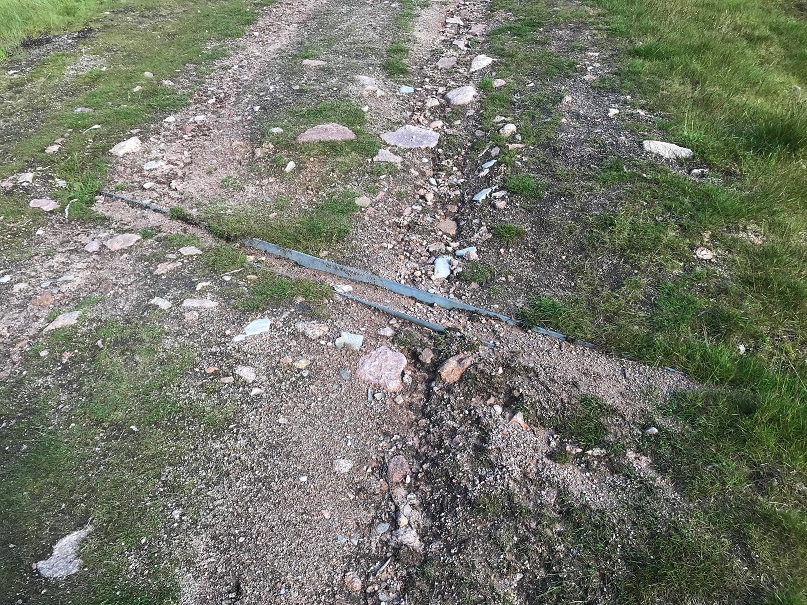
All this damage has happened in a couple of years. What will this track be like in two years time or even after the recent downpours?
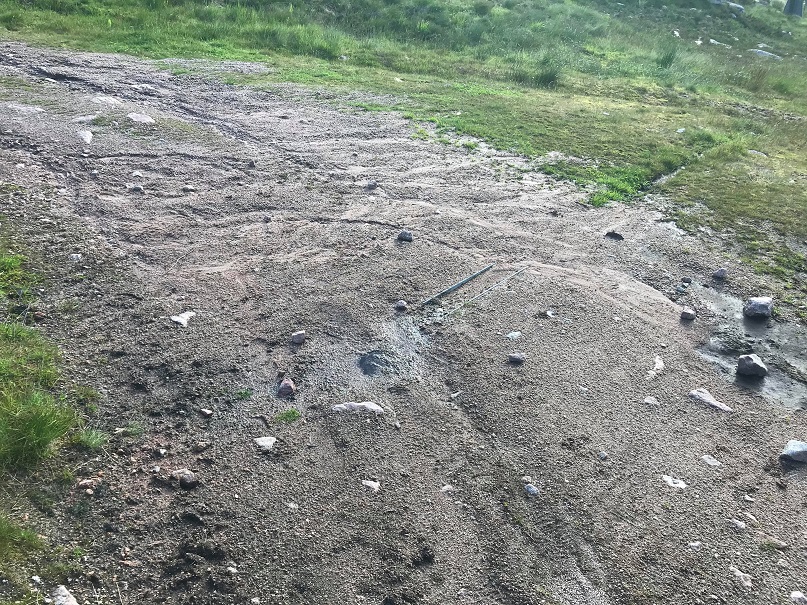
Moreover, Condition 1 of the Planning consent required “landscaping, drainage and groundworks having to be completed by May 2018………and thereafter maintained in accordance with approval.” There is no evidence of HIE or Cairn Gorm Mountain Scotland Ltd having undertaken any maintenance this year which has added to the problems.
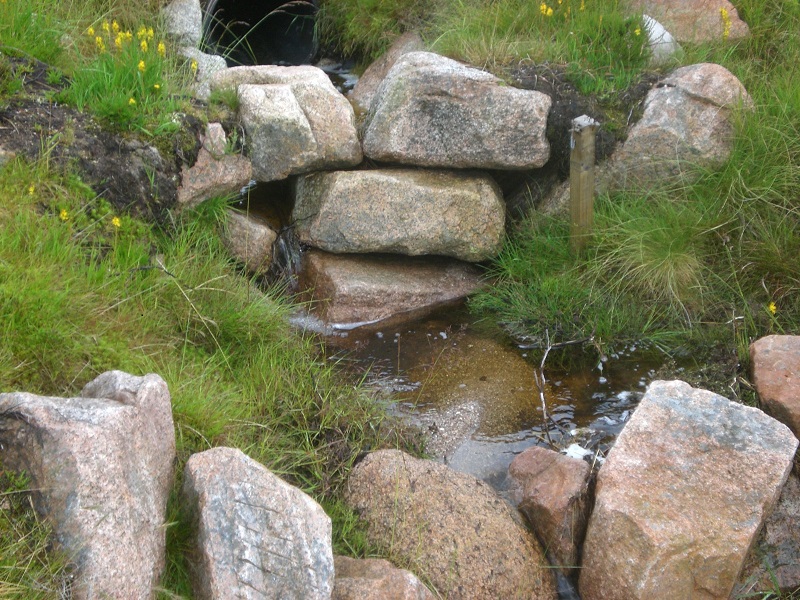

Prevention of ground damage at Cairn Gorm


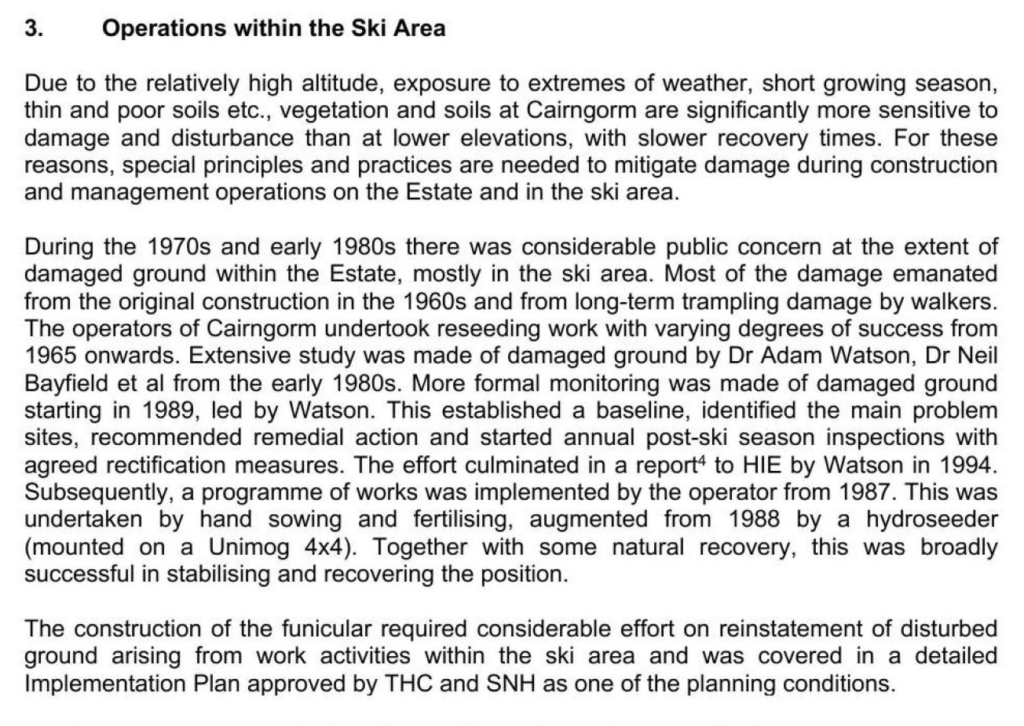
The environmental crime – and I would describe it as no less – is that since the construction of the funicular, HIE has effectively abandoned all those standards. Why should anyone believe that they are now suddenly going to abide by them again? Before doing any new work, HIE needs to engage indepedent environmental experts to survey all the damage that has taken place over the last 15 years and come up with a comprehensive ground restoration plan. Only when that has been completed should the CNPA contemplate approving any new planning applications.
Responding to the Planning Application
If you are concerned about the likely environmental consequences of HIE’s proposal to engineer a new beginners ski area or believe that this won’t help skiing on the mountain, you can lodge an objection through the comment section on the Planning Application (see here).
The North East Mountain Trust has already done so (see here) and one of the excellent points they make is that HIE’s proposal to complete the work before the end of the year is totally contrary to their “Working with the Environment” documents. That says it all! The current deadline for comments is 2nd September.
The proposed areas and the one below the Shieling have for over 50 years been the beginner zones and millions have learned to ski and board here with all the associated humps and hollows. Area “K” would also appear to have nothing to do with “smoothing”, but more as a dumping ground for materials not used elsewhere or to shore up the Carpark Tow base station. There is only one factor involved with this application and that is financial. It cannot be denied that it is cheaper to make snow for a smooth area than one covered in heather, but that also means that as the ground vegetation recovers it will need grooming every year to maintain it’s “smoothness”. Will planning applications for this be re-submitted every year? There are cheaper and more environmentally friendly ways to create a smoother terrain, details of which have been supplied by SNH, and for which there are grants available but these appear not to have been considered. The CNPA requested a Masterplan from HIE before further works were contemplated and this has been completely ignored, a complete lack of professional courtesy by HIE/ CMSL. This is also only a fraction of the approximately 229,000 sq.m. proposed in the SE Group report of 2018. The CNPA should put this application on hold until the “Masterplan”, which has been promised for several years, is produced. This is after all part of a National Park not a theme park.
This whole unfolding situation is alarming. After the 1976 winter alympics in the Alps, a trend arose in Alpine ski resorts for the smoothing out of pistes. It was called plannification – as there was no word in English that descried it. It lead to a range of complications which were not really predicted.
On Cairn Gorm, Adam Watson, in his evidence to the 1981 public inquiry into the proposed ski develeopment towards Lurchers Gully, presented evidence that indicated strongly that, while the frequency of flash foods on the Nethy and the Feshie had remained constant over the last 30 years up to 1980, it had tripled every ten years on the Cas and this was attributed to the impacts of erosion on Cairn Gorm. These flash floods twice removed the bridge over the Cas – the second time in 1981 during the public inquiry. I am unsure of the date of the first but I recall clearly the face of Ian Hudson of Highland Guides as he told me he had been driving a minibus full of clients down from Coire Cas and, as he approached the bridge, something – he did not know what – made him glance upstream. That glance he was clear, saved his life and those of his clients as he say a wall of water and stones coming down onto the bridge and taking it out where he would have been if he had not glanced upstream. In short that flash flood came within seconds of causing multiple casualties. Erosion has very serious results.
Also, it is important to recall the evidence how erosion behaves on mountains. It is not simply a gradual process. What tends to happen is that the mountain plant soil system becomes progressively weakened by numerous interventions etc and then comes one of those major weather events that mountains are prone to and there is a maor event like a large washout, flash flood etc and major damage. Cairn Gorm is probably working its way towards such and event.